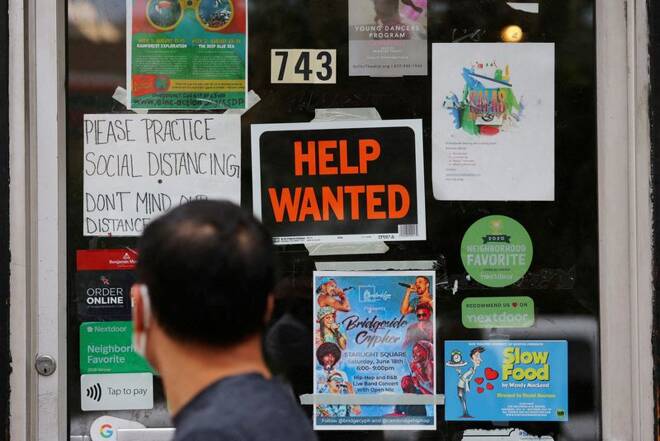Advertisement
Advertisement
Take Five: Next up, it’s U.S. payrolls and euro zone inflation
By:
(Reuters) - Global economic unease is growing and the closely watched monthly jobs report in the United States and inflation gauges in Europe will arrive in the coming week at a key juncture for markets and central banks.
(Reuters) – Global economic unease is growing and the closely watched monthly jobs report in the United States and inflation gauges in Europe will arrive in the coming week at a key juncture for markets and central banks.
A look at manufacturing activity in China is also due, while the euro is threatening to push decisively below the key $1-mark.
Here’s a look at the week ahead in markets from Dhara Ranasinghe, Tommy Wilkes and Vincent Flasseur in London, Lewis Krauskopf in New York, Kevin Buckland in Tokyo and Sumanta Sen in Mumbai.
1/ JOBS CHECK-IN
Monthly U.S. jobs data on Sept. 2 will test the argument that the world’s biggest economy is in solid health, and indicate whether the Federal Reserve can engineer a “soft landing” even as it hikes interest rates to fight inflation that has been running at four-decade highs.
Those arguing against the prospect of a recession, despite two straight quarters of shrinking U.S. gross domestic product, have been able to point to the strong labour market, at least so far.
In July, nonfarm payrolls increased by 528,000 jobs, the largest gain since February. Early estimates for August are projecting an increase of 290,000, according to Reuters data.

2/ INFLATION SHOCK
Inflation in the euro area remains uncomfortably high, the flash August consumer price index on Wednesday is likely to show. That will only pile pressure on the European Central Bank to hike rates again in September even as recession risks mount.
Instead of peaking soon, as hoped just a few weeks ago, inflation could soon hit double digits. It was at an annual rate of 8.9% in July – well above the ECB’s 2% target.
The source of fresh inflation angst is clear: soaring gas prices, which lurched higher again as Russia signalled another squeeze on European gas supplies.
Gas prices are up 45% in August, and 300% this year. Where they go from here remains the key to when euro zone inflation will finally peak. As one economist put it, we’re all becoming gas watchers now.

3/ FACTORY FUNK
China’s moribund economy may continue the lead from the U.S. and Europe in reporting manufacturing gloom in the coming week.
Official PMI data for this month is due on Wednesday, after a surprise contraction in July as COVID-19 flare-ups fuelled by the Omicron variant of the virus forced further clampdowns under China’s draconian zero-COVID policies. The Caixin private survey follows the next day, and is also at risk of dipping into contraction territory.
Consumer and business confidence continue to be hit by the ongoing property crisis. And now a searing heat wave is also hampering production.
China’s authorities are trying to salvage growth this year, with the central bank cutting additional lending rates on Monday after slashing others the week before. On Thursday, the government announced it would take steps to strengthen the labour market, providing the stock market with a bit of cheer.

4/BACK BELOW PARITY
Once again in recent days, one euro became worth less than a U.S. dollar. The currency’s tumble to new 20-year lows near $0.99 is emblematic of the scale of the challenges facing the bloc, not least an energy crisis hitting the euro zone harder than elsewhere.
Another dramatic jump in natural gas prices ahead of peak winter demand in a region still dependent on Russian supplies is fanning inflation fears, as well as expectations the ECB will hike rates faster even as the economy slides towards recession.
Euro/dollar is increasingly correlated with gas prices, and investors and analysts predict further weakness as Russia continues curtailing its exports.
On a trade-weighted basis, the euro is falling fast too, and recently reached its lowest level since February 2020, when the start of the COVID-19 pandemic rattled world markets.

5/STOCKS’ CRUELEST MONTH
The U.S. stock market’s rebound has lost some steam, just as it is entering what has been on average its most treacherous month.
Since 1950, the benchmark S&P 500 has fallen an average of 0.5% in September, the worst monthly performance for the index and one of only two months to register an average decline, according to the Stock Trader’s Almanac, which notes that fund managers tend to sell underperforming positions as the end of the third quarter nears.
This September, a number of factors could set investors on edge. Following the Jackson Hole central banking symposium in Wyoming, the Fed will hold its next policy meeting on Sept. 20-21. Ahead of that comes the latest reading on consumer prices that will indicate if inflation has peaked and is likely to cause volatility no matter where it lands.

(Compiled by Lewis Krauskopf; Editing by Paul Simao)
About the Author
Reuterscontributor
Reuters, the news and media division of Thomson Reuters, is the world’s largest international multimedia news provider reaching more than one billion people every day. Reuters provides trusted business, financial, national, and international news to professionals via Thomson Reuters desktops, the world's media organizations, and directly to consumers at Reuters.com and via Reuters TV. Learn more about Thomson Reuters products:
Advertisement
